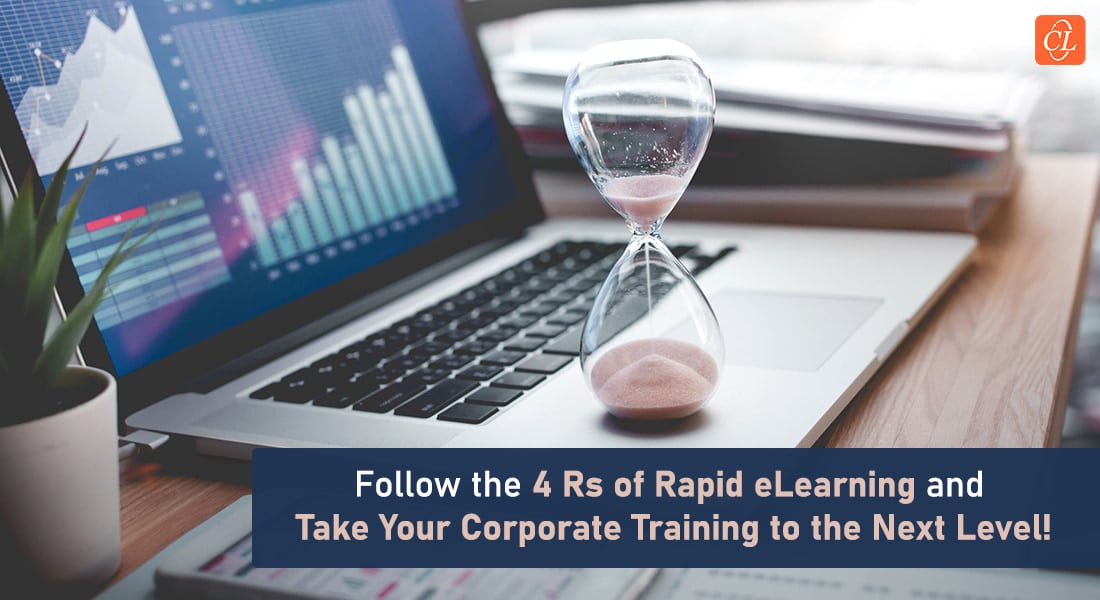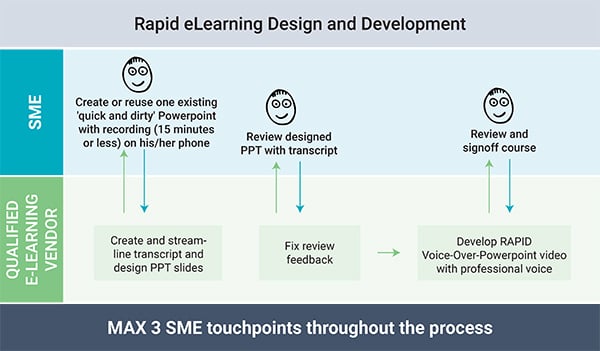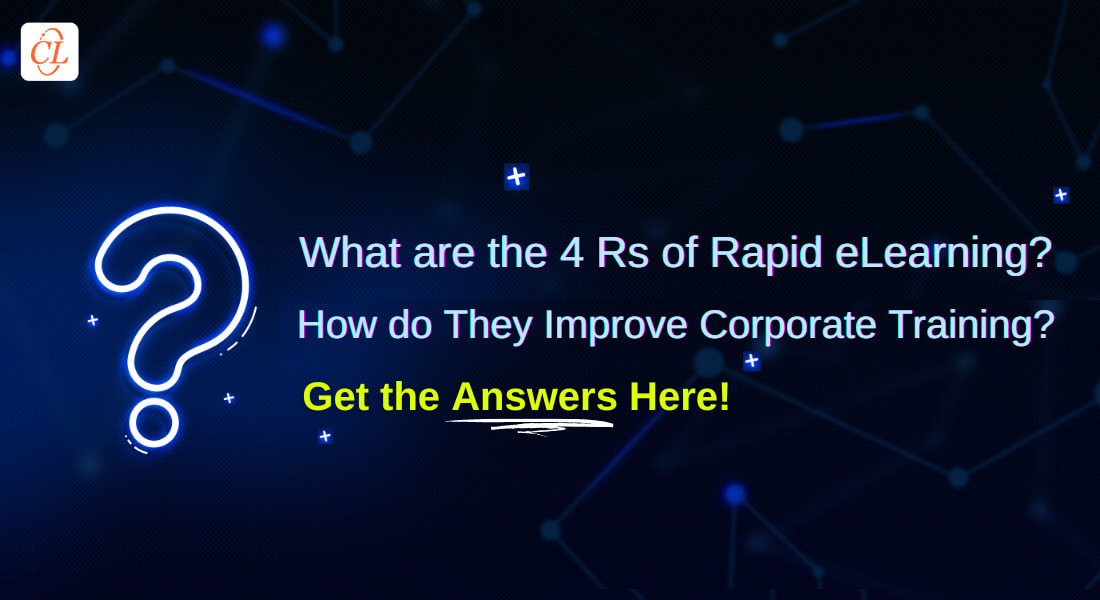4 Rs of Rapid eLearning to Transform Your Corporate Training

Change is the only constant. But coping with change is challenging. This is true even for the corporate training landscape. The pandemic has brought a paradigm shift in the corporate training domain and as an L&D leader, you must be trying hard to make things fall in place. Training needs have increased to match the new modus operandi. Innovation taking the center stage to stay competitive has also added to it.
So, what do you look forward to for uninterrupted continual learning? Is it optimizing cost and time, while ensuring the quality remains uncompromised? Well, when your management wants you to do more with less, rapid eLearning can be a savior. Read on to unleash the power of rapid eLearning.
Rapid eLearning is the Key to Transform Your Corporate Training.
The secret lies in the 4Rs of rapid eLearning. They are:- REDESIGN
- RECORD
- REBUILD
- REPUBLISH
Rapid eLearning: What is it and What it Isn’t?
First things first. Rapid eLearning is not enabling quick eLearning development using authoring tools while compromising on quality. Rather, rapid eLearning offers the know-how to design, develop, and roll out eLearning courses within weeks (unlike conventional eLearning which can take months). Let’s see what all it entails.
Rapid eLearning:
- Is based on instructional design and adult learning principles
- Leverages the power of authoring tools and templates to offer standardization of courses
- Helps design high-quality eLearning courses by incorporating new-age learning strategies that boost learner engagement.
- Offers scale and speed to your corporate training and enhances the effectiveness of training
- Enhances employee performance and helps meet organizational goals, thereby boosting training ROI.
In a nutshell, rapid eLearning can take care of all your training needs; right from converting your classroom training material to eLearning, legacy course conversions, and eLearning translations.
You must be thinking about how rapid eLearning can do all this? Well, the secret lies in the 4Rs of rapid eLearning.
4Rs of Rapid eLearning for Robust Corporate Training
The 4Rs of rapid eLearning offers you the opportunity to revamp your existing conventional training content to a more engaging eLearning course that ensures an immersive learning experience.
Let’s have a look at the 4 Rs:
- REDESIGN
- RECORD
- REBUILD
- REPUBLISH
REDESIGN
Most organizations have been using conventional classroom training as their core training strategy. If you too have been doing the same, you must be aware of the cost associated with it; be it venue rent, accommodation, trainer fees, commuting, printing handouts, and so on. Moreover, the pandemic has prompted organizations to go for alternatives as classroom training is no longer a sustainable training solution. Especially for your globally dispersed workforce.
The Redesign Strategy offers you the most viable solution for converting your classroom training material into online learning formats like:
- VILT (Virtual Instructor-led Training)
- eLearning courses
- Performance support job aids
You can choose the format depending on your learners, learning environment, content, and time available.
VILT (Virtual Instructor-led Training)
VILT is a replica of the physical classroom that delivers training in a virtual environment while keeping the essence of face-to-face classroom training intact. Most people confuse virtual instructor-led training with webinars or online presentations. But it is not so as VILT sessions can replicate the engagement of a real classroom as the learners are engaged through various activities like breakout rooms, discussion forums, polls, and chats.
Wondering how to motivate learners in a virtual classroom? Here’s the secret sauce.
eLearning Courses
Depending on your training needs, you can redesign your existing classroom content into eLearning courses – standalone or curriculum of courses.
Standalone courses are usually short courses of 20-30 minutes and focus on a single topic comprehensively. However, curriculums are a set of interrelated, short standalone modules offered in sequence to cover many learning points.
Performance Support Job-Aids
As the name suggests, these assets can boost employee performance by facilitating continual learning. They also help in refresher training and help improve retention. Your classroom training material can be repurposed to bite-sized learning modules like infographics, videos, comparison charts, and so on and used for effective just-in-time training.
The above alternatives offer a multitude of benefits to learners and the organization. Learners have the flexibility of accessing training anytime, anywhere and can enjoy self-paced learning. It also enables them to experience the liveliness of classroom training in a virtual environment. Organizations, on the other hand can save costs associated with classroom training.
RECORD
The biggest challenge in rolling out eLearning courses within set timelines is the availability of the SMEs (Subject Matter Experts). As SMEs are busy high-profile professionals, it is hard for them to make time to review content or clarify queries. However, being domain experts, their input is crucial throughout the eLearning development process to ensure the accuracy of the content.
The Record strategy is a true savior as it minimizes the time of the SME’s involvement in the eLearning project, while ensuring the development team has an in-depth understanding of the content.
You must be wondering how.
Well, unlike the conventional eLearning development process where there are a minimum of 9 SME touchpoints, rapid eLearning offers a 5-step process with a maximum of 3 SME touchpoints.
- Step 1 (SME Touchpoint #1): SME creates a rough PowerPoint deck and records the explanation for the PPT slides on the cell phone or an audio recording app/software.
- Step 2: The Instructional design (ID) team enhances the PPT deck, adding graphic elements and interactivities; and creates the narration script (from the SME’s audio recording)
- Step 3 (SME Touchpoint #2): SME reviews the designed PPT and script.
- Step 4: The ID team develops a rapid voice-over PPT video with professional narration.
- Step 5 (SME Touchpoint #3): SME reviews the course and signs off.

Seems quite easy and seamless right? Well, it is. This not only saves time for busy SMEs but also enables the rapid rollout of eLearning courses.
REBUILD
If you have been in the eLearning business for long, you must be having a pool of eLearning courses. And I am sure some of the old lengthy courses might be simply lying untouched. How about repurposing them into small, dynamic learning nuggets and offering better learner engagement?
The Rebuild strategy offers you the scope to revisit your legacy courses and repurpose them into bite-sized microlearning modules in the form of videos, eBooks, podcasts, infographics, or flashcards. These modules can be used as standalone courses or curricula of interrelated standalone courses to impart training in various scenarios and are ideal for just-in-time learning.
Each microlearning module is focused on a single learning objective and due to their pocket size and easy accessibility, they are extremely popular among modern learners. These modules are extremely engaging, reinforce learning, and foster learner retention.
So, what are you waiting for? Deploy the rebuild strategy and offer your learners a rich learning experience.
REPUBLISH
If you are no stranger to eLearning, you most likely have several obsolete legacy courses that are no longer compatible with mobile devices or modern authoring tools. Planning to trash them? Hold on!
You can deploy the Republish strategy to extract relevant material from the legacy courses and republish them with a fresh look and feel and enhance their utility. The strategy allows you to:
- Upgrade legacy courses and add new interactivities by leveraging modern authoring tools
- Revamp the look and feel of visually unappealing courses
- Update content and branding
- Design mobile-compatible courses for better reach
Parting Thoughts
Whether it is rolling out courses under budget and time constraints, designing courses that enhance learner engagement, or revamping your legacy courses – rapid eLearning can be a one-stop solution. It can offer the desired scale and speed to your corporate training. Deploy the 4Rs of rapid eLearning and reap the multitude of benefits it offers to scale your corporate training to new heights.
Are you looking forward to implementing rapid eLearning in your organization? Here’s a comprehensive guide on rapid eLearning development that’ll guide you through the journey. Grab your copy now!





